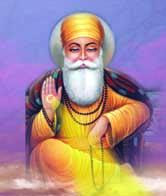Sindhi Shabd
2 aaj din sabhago aayo
3 Aaj Koyal Mithi Kook Kai Aa
4 Dhan Dhan Shri Guru Nanak Sahib
5 Dhan Guru Nanak Sara Jag Tariya
6 Jahinkhe Nanak Shahji Oat
7 Kar Mehar Tu Asante
8 Guru Ghar Eenden
9 Guru Nanak Sahibji Dhan Hai
10 Aarti Gagan Mein Thal
11 Ardas
12 Anand Sahib
 |
| Devri Sahib |
Sind is the land of Sufis and saints who gave the message of peace and unity to the whole world.
In the district of Ghotki Sind there is a small village, which is known for great saints and Sufis called Raherki Sahib(Devri Sahib). Devri Sahib is also called Saint Satram Dham (SSD), as this is the place where Saint Satramdas Sahib was born. This is a place where people from all over the world come to get peace of mind and to get their wishes fulfilled.
 |
| Big Devri Sahib |
Who ever comes to Raherki Sahib does not go empty handed. Anybody who comes here with tears in his or her eyes goes back happily and contended.
It is a very well known fact that the 'Holy book at Devri Sahib which
 |
| Devotees reciting Dhuni Sahib at Devri Sahib |
The very first saint who served at Raherki Sahib was saint Sai Khotaram Sahib. Saint Sai Khotaram Sahib was a holy man. He had spiritual powers and was adored by the people all over the Sind. He
 |
| Samadhi of Khotaram Sahib |
Once Sai Jan came to know that the famine had hit many a villages in Sind. Many a people, farmers as well as the Zamindars came to Sai Jan for his blessings.
Sai Jan called upon all the Panchayats and made an appeal to all the Zamindars that since there was lot of food shortage out of total crop of 24 tons per head each Zamindar should bring 5 kgs for the poor & needy people. One of the Zamindar Surajmal said that in this situation offamine it was not possible to take this responsibility and they went away.
Next morning all of them that means all the Zamindars returned back and fell on the feet of Sai Khotaram and pleaded for mercy. When Sai Jan asked them what happened they said that since they refused to do what Sai Jan told them they were not able to sleep. They at night in their dream saw snakes and evil powers who were telling them that they will kill them and after that they got scared and wanted Sai Jan to forgive them for not obeying to Sai Jan's order. On listening to this Sai Jan said that those who repent and understand their mistakes are not punished by the God as he is the greatest of all.
History of hinduism

What is the history of Hinduism?
Hinduism is the oldest and one of the most complex of all religious systems. It is difficult to provide adequate history of Hinduism because it has no specific founder or theology. The development of this religion was influenced when light-skinned nomadic Aryan Indo-European tribes invaded Northern India BC from Russia and Central Asia attacking the Harappan people who lived there in 1500. The word, Hinduism, comes from the word, Indus, which is the name of an Indian River that existed about 5000 years ago.
Both groups adopted the beliefs of the other so they were similar in their religious doctrines. The Aryans believed in multiple gods to worship and the Harappans believed in the sanctity of fertility.
The Aryan group developed what is called the caste system, which ranked society according to occupational class. That system is as follows: Brahmins are priests; Kshatriyas are soldiers, king-warrior class; Vaishyas are merchants, farmers, Sutras laborers and craftspeople; Harijahns are "untouchables" -- those thought to be descended from the Harappan aboriginal people who are extremely poor and discriminated against. The higher the person's caste, the more the person is blessed with the benefits and luxuries of life. The system was outlawed in 1948, but it is still important to the Hindu people and recognized as the proper way to categorize society.
The Hindu religion has branched out and now encompasses a wide variety of religious beliefs and organizations. Portions of the Hindu beliefs have found their way into other countries, and are the foundation of other religions such as Transcendental Meditation and Buddhism.
As we continue on in learning the history of Hinduism, it would be interesting to note some of the Hindu scriptures.














